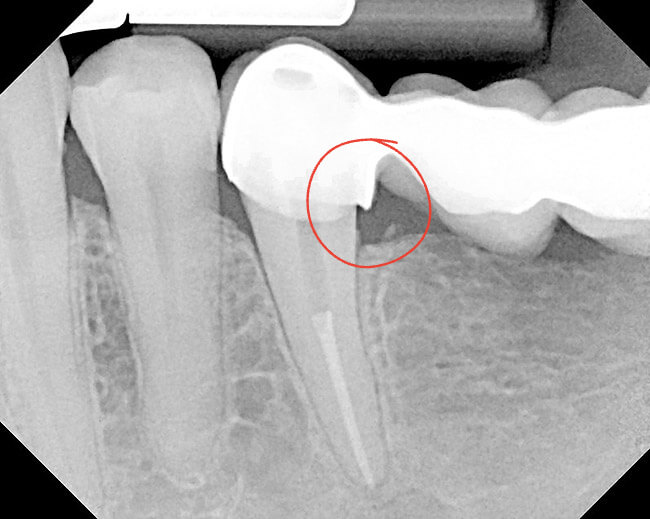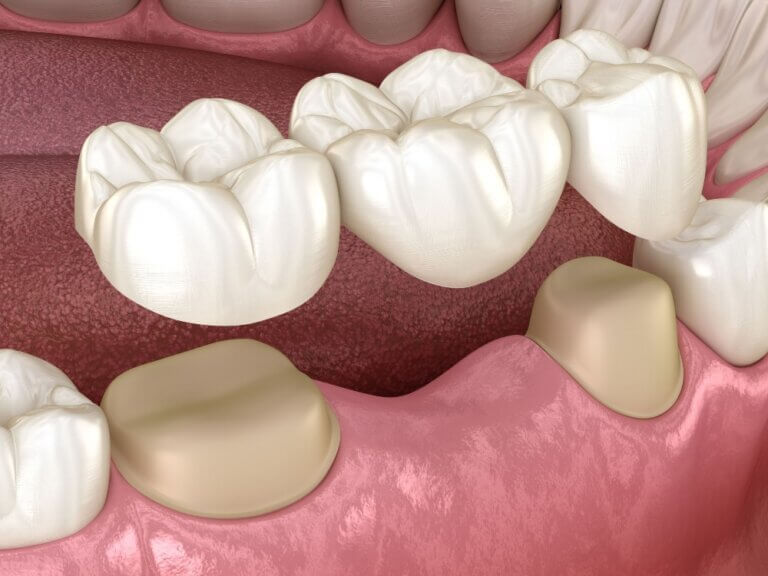Dental Bridge Overhanging Margin

What Is A Dental Bridge Overhanging Margin?
A Dental Bridge is a prosthetic dental appliance that is used to replace one or more missing teeth. It consists of two or more dental bridges that are placed on the teeth on either side of the gap created by the missing teeth, with a false tooth or teeth (pontic) in between them. The dental bridge is then anchored in place by cementing it to the adjacent teeth, which serve as abutments. When designing the dental bridge, there should be a smooth, continuous surface from tooth to bridge that will prevent bacteria and food from getting trapped at the margin.
If you’ve ever had a Dental Bridge placed, you may have heard the term “overhanging margin” mentioned by your dentist. This refers to a situation where the edge of the bridge extends past the natural contour of the tooth it’s covering, resulting in a small ledge or “overhang” that can trap food particles and bacteria.
While a slight overhanging margin is not uncommon and may not cause any immediate issues, if it is left unaddressed, it can lead to problems like tooth decay, gum disease, and even tooth loss. Therefore, it’s important to understand the causes of overhanging margins and how they can be prevented or corrected. Before you contact a Toronto dentist to examine A Dental Bridge Overhanging Margin, there are some things you should know as a patient:
- Why Do I Have A Dental Bridge Overhanging Margin?
- Signs And Symptoms Of A Dental Bridge Overhanging Margin
- Treatment Options For A Dental Bridge Overhanging Margin
- How To Prevent A Dental Bridge Overhanging Margin
- Managing A Dental Bridge Overhanging Margin Until You Can See The Dentist
If you have questions about A Dental Bridge Overhanging Margin or other dental problems, please contact us for more information.
Why Do I Have A Dental Bridge Overhanging Margin?
There are several reasons why you may have a dental bridge overhanging margin, including:
- Poor Bridge Design: When the dental laboratory designs your permanent dental bridge, they should ensure that the margin of the tooth preparation is flush with the bridge margin design. In doing so, there should be a smooth, continuous surface from tooth to bridge that will prevent bacteria and food from getting trapped at the margin. If the lab does not properly identify where the margins of the bridge are, a ledge or overhanging margin can result.
- Poor Bridge Impression: Sometimes this is not the fault of the dental lab. Inaccuracies can be introduced at the time the dentist takes an impression of the prepared tooth: less accurate physical impressions used instead of newer digital scanner impression techniques, moisture or blood preventing accurate impressions, excess gum tissues covering the tooth margins, etc.
Understanding the potential causes of an overhanging margin can help you take steps to prevent it from happening or address it if it does occur. If you have further questions about why you may have a Dental Bridge Overhanging Margin, please contact us.
Signs And Symptoms Of A Dental Bridge Overhanging Margin
If you have a dental bridge overhanging margin, you may experience one or more of the following signs or symptoms:
- Tooth Sensitivity: You may experience sensitivity or discomfort when eating or drinking hot or cold foods and beverages.
- Tooth Pain: You may feel pain or discomfort when biting down or chewing.
- Gum Swelling: Swelling or tenderness in the gums surrounding the bridge may indicate an overhanging margin.
- Food Trapping: Food and debris may get trapped between the overhanging margin and your gums, causing discomfort. You may find that you have to floss your teeth more often because of the overhanging margin under the dental bridge.
- Noticeable Ledge Under Bridge: You may feel a tangible ledge between the bridge and your tooth, indicating an overhanging margin.
- Dark Discoloration Under Bridge: You may notice dark discoloration or a grayish hue under the bridge, which can indicate tooth staining from the overhanging margin, tooth decay or infection.
- Floss Shredding: This is where dental floss tears or shreds when used around the affected tooth with the overhanging margin.
If you notice any of these signs or symptoms, it’s important to schedule an appointment with your dentist as soon as possible. Your dentist can examine your dental bridge and determine if an overhanging margin is present. If left untreated, an overhanging margin can lead to more serious dental issues, such as tooth decay or gum disease. If you have further questions about the signs and symptoms of a Dental Bridge Overhanging Margin, please contact us.

Treatment Options For A Dental Bridge Overhanging Margin
If you have a dental bridge overhanging margin, your dentist may recommend one or more of the following treatment options:
- Bridge Adjustment: In some cases, your dentist may be able to adjust the bridge to eliminate the overhanging margin if they have adequate access to the overhang. This can involve removing a small portion of the bridge or reshaping it to fit your tooth more accurately.
- Replacement Of The Bridge: If the overhanging margin is significant, difficult to access, or the bridge is damaged, your dentist may recommend replacing the bridge entirely. This can ensure a proper fit and eliminate the overhanging margin.
- Root Canal Treatment: If the overhanging margin has led to tooth decay or damage to your natural tooth, your dentist may recommend root canal therapy to remove the damaged tissue and preserve the remaining tooth structure.
- Bridge Lengthening Gum Surgery: In some cases, gum surgery may be necessary to remove the overhanging margin and restore a proper fit between the bridge and your natural tooth.
The appropriate treatment option will depend on the cause and severity of the Dental Bridge Overhanging Margin. It’s essential to schedule an appointment with your dentist promptly if you experience any signs or symptoms of an overhanging margin to prevent further damage. If you have further questions about treatment options for a Dental Bridge Overhanging Margin, please contact us.
How To Prevent A Dental Bridge Overhanging Margin
Fortunately, there are steps you can take to prevent a Dental Bridge Overhanging Margin. These include:
- Choosing a Qualified Dentist: Make sure to choose an experienced dentist with a proven track record of successful dental bridges. Review their Google reviews to ensure patients are happy with their service.
- Crown Lengthening Gum Surgery: Sometimes, the tooth margins are deep and can be obstructed by excess gum tissue, resulting in inaccurate bridge impressions and an ill-fitting dental bridge. This surgical procedure removes excess gum tissue to expose more of the tooth structure, resulting in cleaner tooth preparation margins. Clean, visible tooth margins are important for accurate bridge adaptation. Ask your dentist if crown lengthening gum surgery is required.
- Digital Scanning Impressions: Dental bridges can be made using traditional physical impression techniques or newer digital impression techniques. Using digital scanning technology with an intraoral scanner can provide more accurate impressions, leading to better-fitting dental bridges and fewer complications. Not all dentists use digital scanning technology, so be to consult with a dentist that uses digital intra-oral scanners.
By following these preventive measures, you can ensure a successful dental bridge treatment and prevent Overhanging Margins Under Dental Bridges. If you have further questions about how to prevent a Dental Bridge Overhanging Margin, please contact us.
Managing A Dental Bridge Overhanging Margin Until You Can See The Dentist
If you experience a Dental Bridge Overhanging Margin before your scheduled dental appointment, you can take the following steps to manage the issue until you can see your dentist:
- Practice Good Oral Hygiene: Keeping the dental bridge that has the overhanging margin as clean as possible. This will help prevent tooth decay and alleviate some of the pain or sensitivity. Brush and floss gently around the tooth. Rinsing your mouth with warm salt water or mouthwash can help reduce infection, inflammation and alleviate toothache pain. You can buy any mouthwash available at your pharmacy or health foods store. Alternatively, you can mix a teaspoon of salt in a cup of warm water and swish the solution around your mouth for about 30 seconds before spitting it out.
- Use Over-The-Counter Pain Medication: Over-the-counter pain medication can help relieve tooth pain or sensitivity from tooth decay under a veneer. You are also welcome to use over the counter pain relievers such as ibuprofen (Advil) or acetaminophen (Tylenol). Ask your dentist what dosage is right for you, but if you do not have a pre-existing medical condition of allergies, 1000mg acetaminophen (Tylenol) with 600mg ibuprofen (Advil) every 4-6 hours or as needed is a very powerful combination.
- Avoid Eating On The Affected Side: Avoid eating on the side of the affected tooth to prevent further irritation or damage to the overhanging margin.
While these measures can help manage Dental Bridge Overhanging Margin until you can see your dentist, it’s essential to schedule an appointment as soon as possible to prevent any further damage. If you have further questions about how to manage and treat a Dental Bridge Overhanging Margin, please contact us.

